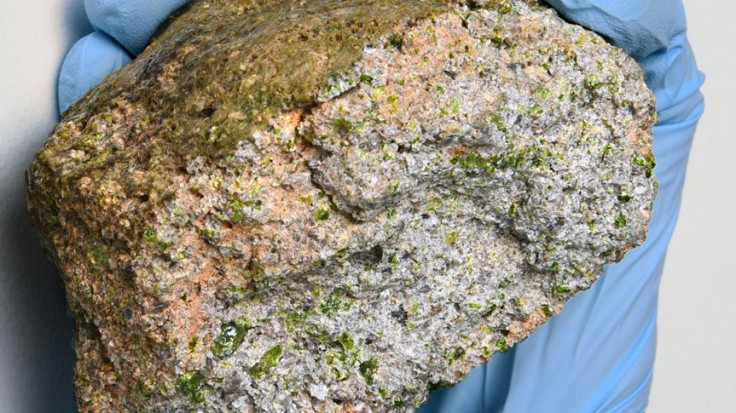Meteorite From 4.5 Billion Years Ago In The Early Solar System Identified

A team of U.S.-based scientists has identified an extremely old extra-terrestrial piece of rock — a chunk of meteorite that formed at a time when our Solar System was going through the earliest stages of evolution and beginning to form planets.
Scientists have long hypothesized that our stellar neighborhood formed some 4.6 billion years ago when our Sun came to life following the gravitational collapse of a cloud of gas and dust. The star was surrounded by a disk of gas and dust, which later coalesced to form the first asteroids and then the planets we see today.
The process took several hundred million years, but according to scientists at the University of New Mexico (UNM), one silica-rich rock from that period traveled through space for billions of years before landing in Mauritania, Africa.
Though it remains unclear when the enigmatic meteorite — laced with green crystals and cavities — crashed on Earth or who discovered it, it ended up with a meteorite dealer, who decided to sell it to Carl Agee — a professor at UNM's Institute of Meteoritics.
From Agee, the rock came into the hands of Poorna Srinivasan, a graduate student who studied the chemical makeup as well as mineralogy of the rock and revealed the history of its origin.
“One of the main things we saw first were the large silica crystals of tridymite which is a similar to the mineral quartz,” Srinivasan said in a statement. “When we conducted further image analyses to quantify the tridymite, we found that the amount present was a staggering 30 percent of the total meteorite — this amount is unheard of in meteorites and is only found at these levels in certain volcanic rocks from the Earth."
Follow-up analysis of chemical properties of the rock led the team to conclude that it formed in the crust of an early solar system asteroid some 4.565 billion years ago or just around the same time rocky planets were beginning to form.
Though Srinivasan and colleagues couldn’t pinpoint the meteorite to any known asteroid in the solar system, they did note that its oxygen isotope value is pretty similar to a few other meteorites. This indicated that the parent body of this rock likely collided with another asteroid or new-born planet during its early life.
“This meteorite is the oldest, igneous meteorite ever recorded," Agee said in the statement. "Not only is this just an extremely unusual rock type, it's telling us that not all asteroids look the same. Some of them look almost like the crust of the Earth because they're so light colored and full of SiO2. These not only exist, but it occurred during one of the very first volcanic events to take place in the solar system."
Meteorites like these, as the researchers said, are critical to understand the initial phase of the Solar System and could reveal how the basic building blocks of planets formed and eventually evolved to create the planets we see today.
The study titled, "Silica-rich volcanism in the early solar system dated at 4.565 Ga," was published Aug. 2 in the journal Nature Communications.
© Copyright IBTimes 2024. All rights reserved.




















